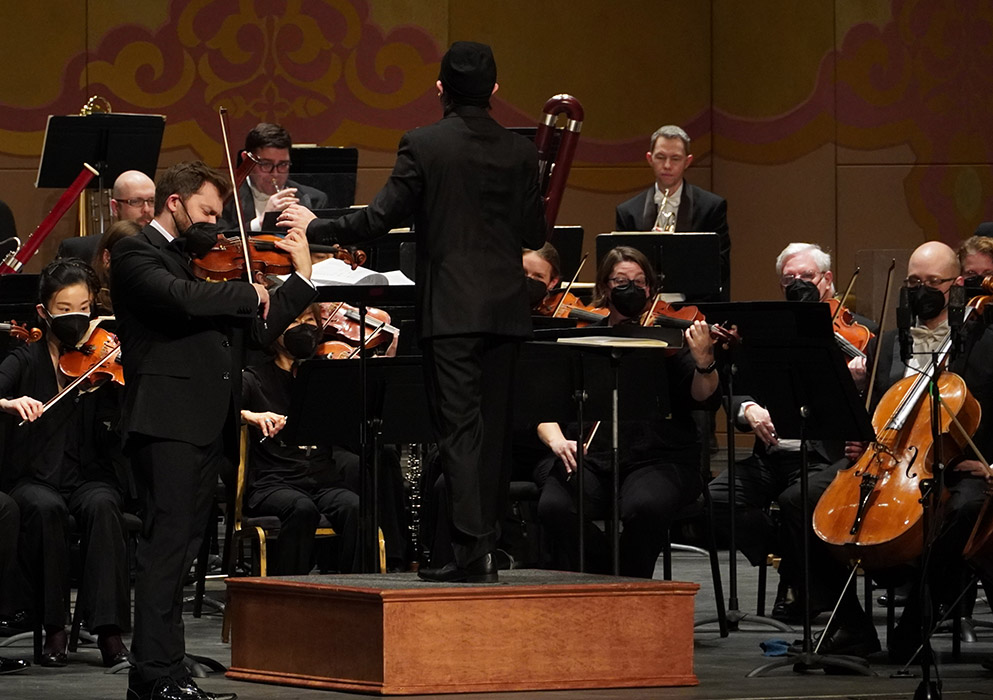There is something of a notable history to the January Masterworks concerts by the Knoxville Symphony Orchestra—a history that seems a bit contradictory on its face. In our coldest month, when inclement weather is likely to influence audience attendances, the KSO appears to delight in creating concerts that seem to radiate an intensity and energy that goes well beyond what would normally be expected any other time. Aram Demirjian, the KSO maestro, himself benefited from this uncanny January magic in 2016 when he conducted his audition concert for the KSO music director position—a high energy concert performed for a small, but equally high energy audience that came out despite the fear of a major snowstorm. [KSO Braves a Winter Weather Scare to Kick Off 2016 Masterworks Concerts]
This past weekend, the KSO’s January Masterworks concerts lived up to that history of magical evenings once again, this time with a journey back into the 20th Century and a look at its vestiges of Romanticism and Impressionism from Maurice Ravel, Samuel Barber, and Ottorino Respighi. Maestro Demirjian also made a side-step comparison of contemporary impressionism with the remarkable The Block by Carlos Simon.
Ravel’s La Valse is, more often than not, heard as a concert closer, its tidal lyricism and explosiveness being useful as a finale. On this occasion, though, Demirjian opened the concert with the 1920 work, offering in his remarks the intent to not shy away from the idea of the waltz as a metaphor for the end-of-an-era in fin-de-siecle Europe unable to face the reality of change. Although Ravel himself denied any kind of symbolism of post-World War I Europe in the work, listeners a century later cannot escape from what was—at the very least—an unconscious reaction to the pain Europe had experienced. Demirjian and the orchestra followed through on this intent, weaving an edge of paradox through the work and tinting the luscious rhythmic sway with slightly twisted and halting repetitions of themes.
Following the Ravel came Samuel Barber’s Violin Concerto, a work that, like the Ravel, was written and premiered at a time of upheaval in the world—1939-1941. However, it is practically impossible to discuss the concerto without touching on the controversy of its commissioned birth, what the controversy says about 20th Century music, and what this means to violinists who take on the satisfying, but idiosyncratic work.
It was KSO Concertmaster William Shaub who was the violin soloist here, a choice that seemed a perfect one based on the dual musical demands of the work. Shaub’s sensational performance beautifully fulfilled the concerto’s Jekyll and Hyde requirements for a soloist: a deep sensitivity for the sunny, vocal-like Romantic lyricism of the Allegro and Andante movements and a passionate and energetic virtuosity for the third Presto in moto perpetuo finale. Shaub’s tone in the Allegro was both luscious and clear, the lusciousness never becoming too dreamy. Equally appropriate, Demirjian and the orchestra radiated lyrical warmth, rather than wallowing in it.
As if the first movement theme was not memorable enough, Barber opens the Andante with a charming melody in the oboe, played here with a gorgeous poignance by Principal Oboe Claire Chenette.

Carlos Simon’s recent work The Block opened the second half of the concert. This propulsive and addictive work flies through instrumental textures, driven forward by a seemingly infinite number of percussion identities.
Perhaps the perfect antidote for a cold night, Respighi’s The Pines of Rome concluded the concert, tapping a host of theatrical emotions: anticipation, mystery, excitement, majesty, and scenic grandeur. The work was a feast of dramatic sculpting by the conductor and a showcase of instrumental textures from the expanded orchestra. Beautiful solo work came from Principal Clarinet Gary Sperl, Principal Trumpet Phillip Chase Hawkins, and English horn Ayca Yayman. Of course, let’s be honest—everyone was secretly waiting for that final crescendo that was exploited here by extra brass playing from left, right, and center balcony, adding a layer of sonic strength and majesty. It is that marvelous acoustic majesty that fills one’s heart and banishes—temporarily at least—a frosty night and 21st Century worries.






